“Expression WordPress Theme” Documentation by “Pexeto” v.1.4.7
Created: 18/08/2012
By: Pexeto
http://pexetothemes.com/
Thank you for purchasing Expression theme. If you have any questions that are beyond the scope of this help file, please refer to the Support section. Thanks so much!
If you like this theme, please don't forget to rate it on the ThemeForest site. Thank you!
Note: If you have any questions that are beyond the scope of this help file, please refer to the Support section.
Theme Requirements
This theme requires the Classic Editor plugin. Please make sure to install the plugin before you start creating content with the theme. You can either install the plugin manually (from the Plugins -> Add New section) or follow the theme's notifications in the admin dashboard that will prompt you to install the plugin.
Getting Started
a. If you are new to WordPress
Although building a website with WordPress is significantly much easier than coding it by yourself, if you are a beginner, even working with WordPress may look hard for you. That's why, in this section we will provide some useful links and also will explain how to get oriented in the documentation and what pattern to follow when building your website with our theme.
Working with WordPress - Useful Links- The WordPress Codex - the official WordPress manual containing lots of information and tutorials about working with WordPress.
- WP101 Basics Training - the perfect beginning spot for those just getting started with WordPress. The video tutorials provided are very helpful to easily understand how WordPress works.
b. Working with the theme
Once you have some basic WordPress knowledge, you are ready to go with setting the theme. Here are some example steps about how you can do this:
- Install and activate the theme - read about how to do this in the Installing and activating the theme section.
Having problems with installing the theme?
» Refer to the "Fail to install the theme" subsection of the Troubleshooting section. - Change your logo - learn how to do this in the Changing the logo section
- Create your basic menu - during the process of setting your theme, you will be changing your menu links all the time. However, it is good to start with having the main menu set. Learn how to set your menu in the The menu section.
- Start with creating your content
You can create all the content by creating your pages one by one. Here are some examples of what steps to follow when creating different pages:
You need a Gallery page to set as home page (in the same way as on the demo):
- Go to Template pages » Grid Gallery Page section - in this section you can read about how to create such a page and all the settings you can do about this page template. You can read about how to create the gallery items and all the options that you can set to them.
- After you set your page, go to the Menus section and add it to your menu so it can be easily accessible.
You need a Blog page:- Go to Template pages » Index/Blog page section to learn how to create a blog page, how to create posts to it and all the settings you can do for this page
- You need to set a slider for the blog? » Go to the Nivo Slider section to read how to create a slider. After you have your slider created and populated with images, you have to select the slider you have created (how to set the slider is explained in both the slider's section and the blog/index page sections)
- You need a separate blog sidebar? » Go to the The sidebars section to learn how to create additional sidebars and how to add widgets to them. After you have created your sidebar, go back to the Index/Blog page section to learn how to set the sidebar you have created to your blog page.
Basically, these are the steps you need to follow - when you need to create a page, just go to its relevant subsection of the Template pages section and read about how to create it and what settings you can do for the page. The main key about understanding how the theme works is to read the documentation we have provided carefully, as we have explained everything you need to know about the theme in here.
- Once you follow all these steps and have the basic theme setup, you can also check the rest of the sections of this documentation to read what other features our theme provides.
We hope you will enjoy working with the theme!
Installing and activating the theme
There are 2 main ways to upload the theme:
- Via the built in WordPress theme uploader
Below you can read the instructions about installing a theme via the WordPress uploader, but you can also watch the "Installing a Pexeto Theme via WordPress Uploader" video here
First you have to unzip the download file and find the zip file called expression.zip. After this you have to go in the admin panel » Appearance » Themes, click on the Install Themes tab and in this section in the top there is a link "Upload". After you click the "Upload" link, a new page will be opened where you will be asked to find the .zip file on your local file system.
Note: Some servers have limited access settings and wouldn't allow uploading the theme trough the admin - in these case you have to upload the theme via FTP. - Via FTP client
Below you can read the instructions about installing a theme via FTP, but you can also watch the "Installing a Pexeto Theme via FTP" video here
If you know the FTP login details of the server where your site is hosted and you have a FTP client installed (such as FileZilla), you might consider using this way of uploading your theme. First you have to unzip the download file, find the zip file called expression.zip, unzip it and upload the folder to the main WordPress installation folder » wp-content » themes. Please note that if you prefer this way of installation, you have to make sure that the main files of the theme are contained just within one folder of the themes folder. The right way to locate your root theme files is for example themes/expression but not themes/expression/expression.
After you have uploaded the theme to the server you will need to activate it. In order to activate this theme you have to go to the admin panel » Appearance » Themes. In this section you should see the theme with a title Expression by Pexeto. Just click on Activate button and your theme should get activated.
-WordPress v.3.4 or higher
-PHP v.5.0 or higher
Importing the demo content
If you would like to import the demo content and start editing the theme from the created content rather
than from scratch, you need to import the demo_exported.xml file that is included with the download
folder. You can do this by going to the WordPress admin panel -> Tools -> Import -> Select WordPress,
find the demo_exported.xml file from your local file system and upload it.Please note that not all the settings are saved with the demo exported data, so it is always recommended to set your theme from scratch rather than installing the demo
content and editing it.
Useful instructions back to top
a. Options page
When you activate this theme, an options page is created in order to help you make the theme settings much easier. This page is located in the admin panel » Expression » Expression Options.

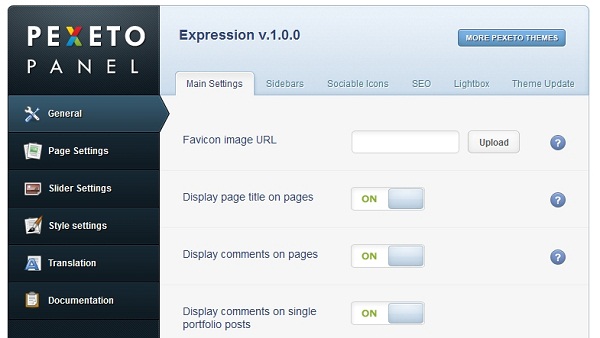
b. Setting a custom field
Many times in this documentation you will be told that you have to set a custom field for a page or post. There are some custom fields that have been created for this theme. Those custom fields are located just below the main content area of the page/post when opened in "edit" mode. For the portfolio items the section is called "Expression PORTFOLIO ITEM SETTINGS" and for the pages the section is called "Expression PAGE SETTINGS".

c. Setting a featured image to a post/page
In order to set a thumbnail (featured image) to a post/page, when creating/editing your post/page in the bottom of the right sidebar
you will see a link "Set a Featured Image":
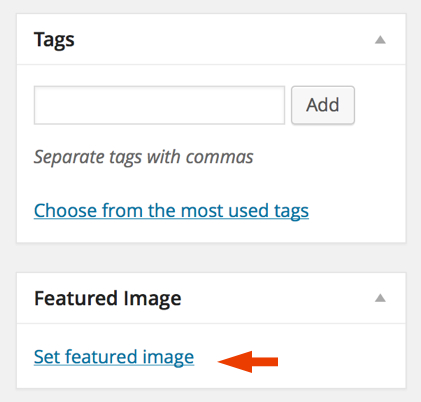
If you click on this link, a window will be opened where
you can choose the image. When you select the desired image, you have to click on the "Set featured image"
link.
The header back to top
The header consists of three main elements:
- Logo
- Menu
- Sociable Icons

a. Changing the logo

The logo consists of two parts - a logo image (in the screenshot above this is the "expression" part) and the WordPress installation tagline (in the screenshot above this is the "Premium WordPress Theme" part).
Changing the logo image
To change the logo image, you can either use your own existing logo image or edit the included logo PSD file - it is called logo.psd and is located within the photoshop_files folder. The font that is used for the "Expression" text is called "PT Sans" (you can download it for free from here)).
After you have your logo image, you have to go to the Expression Options » Styles » Logo
and upload (or insert the image URL) in the Logo Image section. We have also included a Retina display logo image option which allows you to set another logo image for retina displays.
The image size for retina displays should be twice the size of the regular logo - for example if the standard logo image size is 30x70 pixels, the size of the retina display logo image should be 60x140 pixels. If you don't set an image in this field, the image set in the "Logo Image" field will be used on retina displays.
In the Logo section you can also set your logo
image width and height:
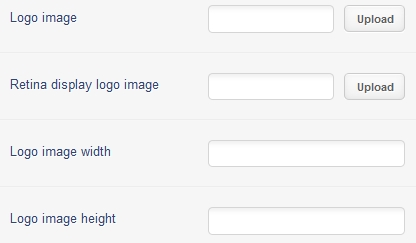
Please note that the size of the image you upload should be in the size you would like it to be displayed.
Changing the tagline
You can change the default tagline in Settings -> General -> Tagline. If you would like to hide it, you can do this in the Expression Options -> Style Setting -> Logo -> "Display site tagline next to logo" field.
b. Setting the menu

Here are the steps you have to follow in order to set the menu:
- Go to Appearance » Menus. To create the menu click on the
"Create a new menu" link.

- After you create the menu, you can
add Page, Category and custom links from the left sidebar. You can watch this video to tutorial to learn more about working
with the WordPress Menus functionality.
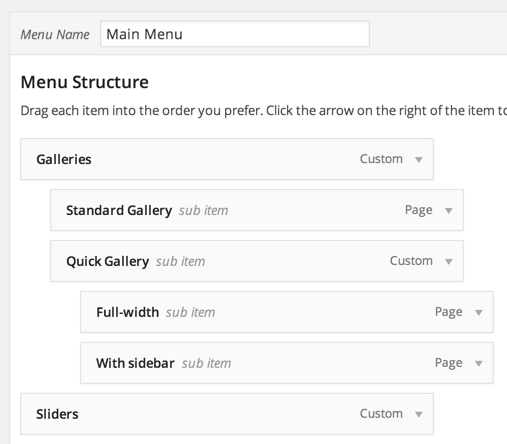
- Then click on the "Manage Locations" tab section and select the menu that you have created
in the "Expression Theme Main Menu" field.

c. Setting the sociable icons

To set the icons, you have to go to Expression Options » General » Sociable Icons section.
First, you have to make sure that the "Display sociable icons" field is set to "ON". After that, you can add
the icons you like into the "Add a sociable icon" field:
1. Select the icon
2. Insert the link of the icon in the "Sociable Link" field
3. Insert a hover title (optional) - this title will be displayed when you hover the icon with the mouse
4. Click on the "Add Icon" field to add the icon
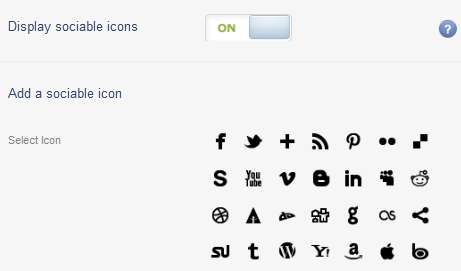
Note: Don't forget to click on the "Save Changes" button after you finish setting the Sociable Icons section.
The footer back to top

The footer is minimal and simple and consists of a copyright section only. You can change the Copyright text in the Expression Options » Translation » Other section.
The sidebars back to top
This theme supports multiple sidebars and they are all dynamic. This means that you can insert whatever widgets you like on them.
There is one default sidebar that goes to each of the pages. If you would like to have more sidebars than the default one, then you can create your new sidebars in Expression Options » General » Sidebars section:
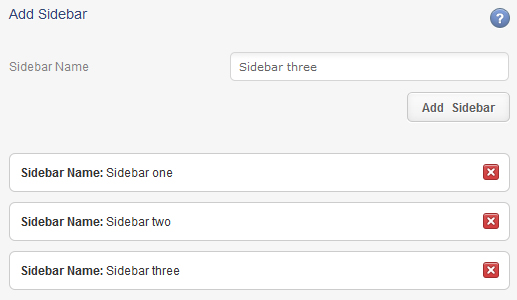
To customize your sidebars you have to go in the admin panel » Appearance » Widgets. There you should see your sidebars on the right part of the page. Now you can drag and drop widgets from the left into your sidebars and that's it!
Here is an example of a sidebar:

Nivo Slider back to top
The Nivo Slider looks like this:
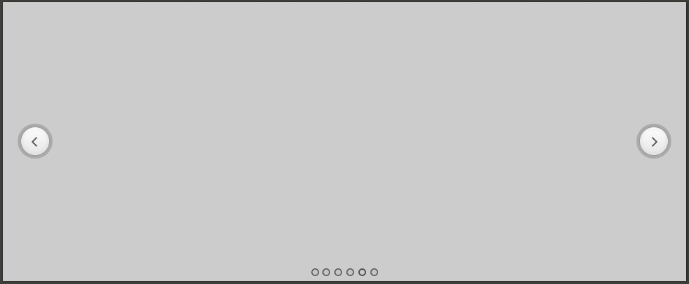
a. Nivo slider in the header of the page
Adding images
In order to add images to this slider you have to go to the Expression » Nivo Slider section. All you have to do is to upload the selected image (or add its URL), link of the image (links can be set to the images, so that when the user clicks on the image to be redirected- this feature is optional) and description (also optional) and press the "ADD" button. After that the image is automatically saved for the slider.
Changing the image orderOnce you add the images, you can change their order by dragging and dropping the image container to the desired place. After you change their order, in order the new order to be saved, you have to click on the "Save Order" button that would appear right above the images:
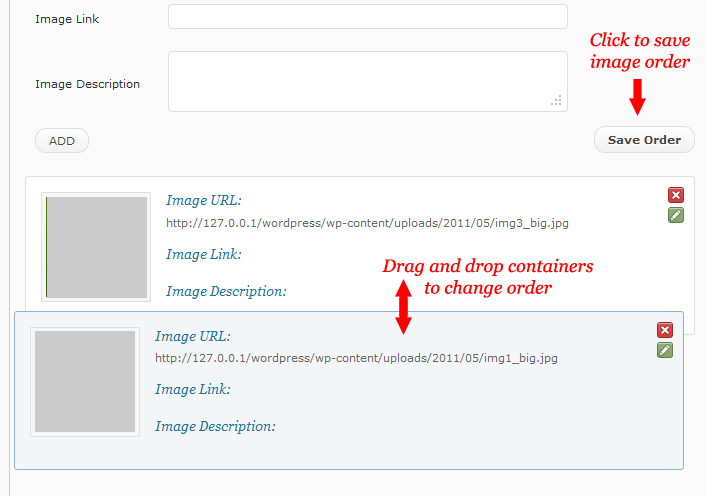
Creating additional Nivo Sliders
If you would like to add a new slider, you have to click on the "Add new nivo slider" button located in the top section of the page and insert its name in the dialog box that will be displayed. After that a section for the additional slider images will be created so that you can set the new images to it.

Changing slider options
You can change the default slider options such as setting automatic image resizing and changing slider speed in the Expression Options » Sliders » Nivo Slider section.
Optimal image size: 980px × 400px
Setting a slider to your pageThe way you set the slider depends on the page you would like to set it to:
1. Blog page - to set the slider to your blog page you have to go to Expression Options » Page Settings » Blog and select your slider from the "Header" select field.2. Standard page - for all other (non-blog) pages, you can select the slider to display in the "Header" custom field that you will see displayed below the main content area when the page is opened in edit mode:
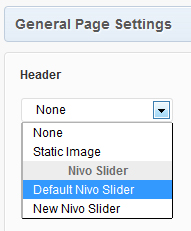
a. Nivo slider in the content of a page/post
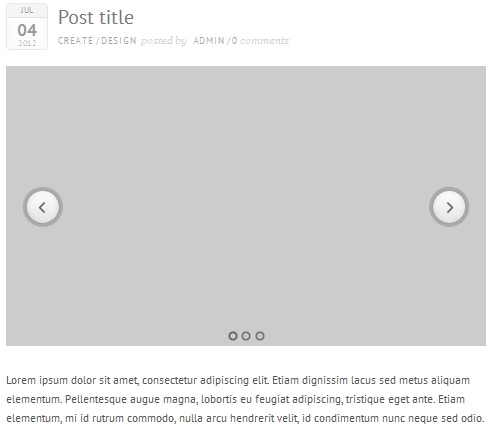
The purpose of the Nivo slider in the content of the page/post is to show the attachment images of the page/post. Image attachments are the images that are uploaded from the post.
Adding imagesIn order to add images as attachments to the page/post you have to:
- Open the page/post in edit mode
- Click on the "Add Media" button above the main content area:

- Click on the "Upload Files" tab and upload the images
- If you would like to change the default image order or edit the images,
select the "Uploaded to this post" option in the filter:

When you edit the images, they get automatically saved.
You can add the slider to any place of your post/page by using the "contentslider" shortcode:
[contentslider]
In the same way like the WordPress gallery, you can also set an "id" attribute if you would like to display the images from another page/post - the id should be set to the page/post ID:
[contentslider id="123"]
Another option the shortcode supports is displaying images from an existing Nivo slider, created from the Expression Options -> Nivo slider section, rather than the post/page attachments. To load a slider from this section, just specify its name in an "name" attribute:
[contentslider name="New nivo slider"]
Also, if you want to add the slider to a standard post and want it to be displayed instead of the featured image, instead of using the shortcode, you just have to select "Gallery" as post format of the post within the "Post Format" section (you can read more about the post formats in the Blog section):
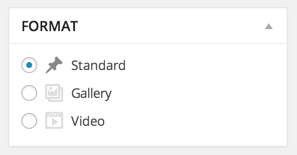
If you create a gallery post, you can select whether to load the images from the post attachments or from an existing slider in the "Gallery post type slider - display images from:" custom field of the post.
Changing slider options
You can change the default slider options such as setting automatic image resizing and changing slider speed in the Expression Options » Sliders » Nivo in content section.
Template Pages back to top
a. Portfolio Grid Gallery Page
The Grid Gallery page is the one that you can see on the theme demo as front page:
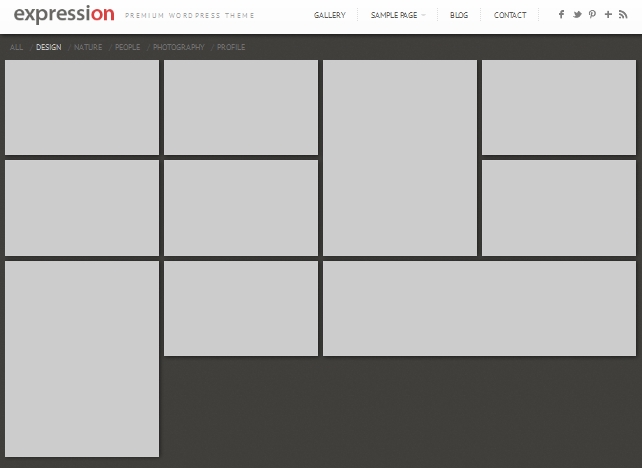
In this section the main steps you would need to accomplish in order to set this page are explained, more options and settings are described in the "Other Gallery Page Options" section below.
Setting The Page:- Create a new page (Page » Add New)
- Select "Portfolio Grid Gallery" in the "Template" field (located in the right sidebar of the edit page section
- If you would like to make this page a front page (to be opened by default when the site is visited) go to
Settings » Reading » Front page displays » Select "A static page" and select the page that
you have just created in the Front Page list:

Creating the portfolio/gallery items (adding images to the gallery)
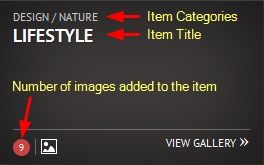
Each of the images in the gallery represents a single Portfolio Item. For each of the portfolio items:
- Creating new items
You can create a new item in "Portfolio" » Add New section. You can set the title in the "Title" field of the item. - Add Images
Note: WordPress 3.5 implemented a new Media management interface which changed the way the images are added to the slideshow. Now the theme requires to insert a gallery into the content of the portfolio item containing the images you would like to display. Updating the theme to version 1.2.0 will automatically add the gallery to existing portfolio items.- Click on the "Add Media" button above the main content area:

- Open the "Create Gallery" section. If you would like to upload new images click on the
"Upload Files" tab and upload the images. If you would like to add existing Media Library
images, click on the "Media Library" tab and select the images you like. After you select
the images, click on the "Create a new gallery" button.
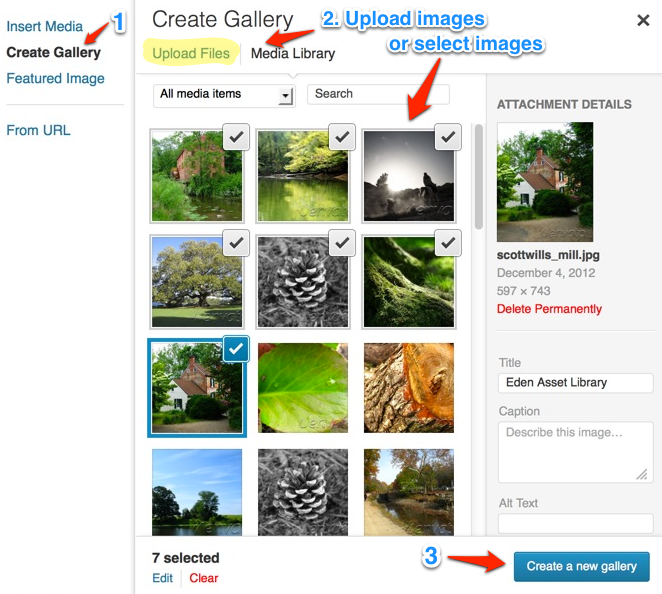
- After this when you click on each image in the gallery, in its Caption field you can set a description to it. You can also change the default image order by dragging and dropping the images on different positions.
- When you finish editing the images Click on the "Insert Gallery" button. This will insert a gallery object into the content section of the portfolio item.
- Later if you would like to edit the images, click on the gallery object and click on its "Edit Gallery"
button:
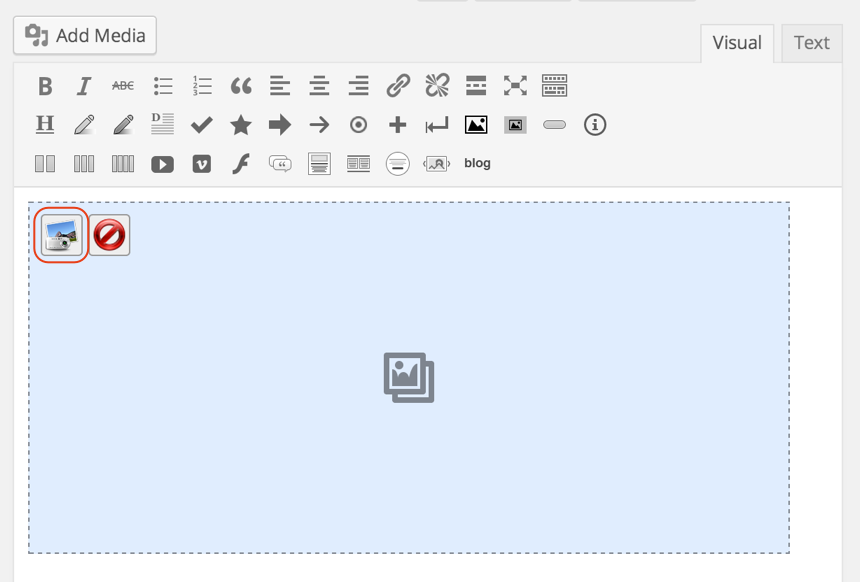
- Click on the "Add Media" button above the main content area:
- Setting the thumbnail of the item
By default the first image of the images you have added will be used as the item's thumbnail. If you would like to set another image as thumbnail, you have to set it as featured image to the item. You can read about how to set a featured image here.
As the images uploaded would be bigger, the thumbnail image will be resized automatically to the size in which it should be displayed. However, if you prefer to use your custom thumbnail image, you can set it in the "Custom Thumbnail URL" field of the item.
- Changing the default thumbnail size and layoutYou can set the default layout of the thumbnail in the "Image Layout" field of the item:
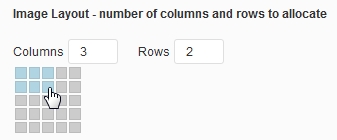
By default the thumbnail will allocate one column and one row, but if you want it to be bigger or displayed in a more lanscape or portrait layout, in this section you can select the number of columns and rows to allocate. The default column and row size can be changed in the "Base Image width" and "Base Image height" fields of the Grid Gallery page.
Example: If you would like to set a portrait oriented image, you would select 1 column and 2 rows.Also you can specify how the thumbnail will be cropped in the "Crop thumbnail from" section:

- Selecting the type of the item
Each portfolio item supports different formats in which it can be displayed. You can select the type of the item in the "Item Type" field:
- Full-width slider and Full-height slider - the item will be displayed in a slider containing all the images added. The difference between the two types of sliders is that with the full-width slider the display width is the same as the window width and the height varies depending on the image aspect ratio - it is mostly suitable for landscape oriented images.
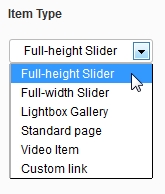
Here is an explanation for each of the item type options:
The full-height slider displays the image in its full height, depending on the window size and the width varies depending on the image aspect ratio. This page template is suitable for both portrait and landscape oriented images.
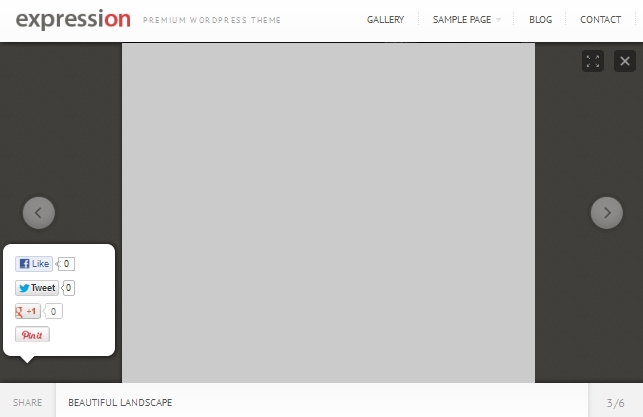
The sliders also provide a sharing functionality - by default Twitter, Facebook, Pinterest and Google+ are included, but you can remove any of them or add new buttons in the Expression Options -> Slider Settings -> "Gallery Slider" section.
- Lightbox Gallery - if you select this option the images of the item in the Grid Gallery will be displayed lightbox:

With this type selected, the single portfolio item page will automatically include a Quick gallery with option to open the images in lightbox. - Standard Page - the item will be displayed in a standard page format. In the "Standard page item type settings" section of the item you can select the layout and sidebar for the page.
- Video Item - in the Grid Gallery, a video in lightbox will be played after clicking on the item thumbnail. For the video link you have to set the custom field Custom Link/Video URL by inserting the Video URL in there.Here are some examples of inserting videos:
- YouTube video:
http://www.youtube.com/watch?v=geplBr2fcZc - Vimeo:
http://vimeo.com/11326568Please note that a vimeo link containing www is not valid (such as http://www.vimeo.com/11326568)
- Flash Alone:

Please note that you need to insert width and height of the video in the URL of the flash video.
With this option selected, the single portfolio page of the item will contain the video embedded in the content of the page.
- Custom Link - after clicking on the item the user will be redirected to a custom link that you have set in the custom field "Custom Link/Video URL" of the item. - YouTube video:
- Set a custom order to the item - by default the items are ordered by date, however if you would like to set them in a custom order you can set the gallery to load the items by custom order select "By Custom Order" in the "Portfolio item order" field of the gallery page.
The items with the
smaller order number will be displayed first, which means that an item with order set to 5 will be displayed before an item with order set to 10.
In order to change the default order of the portfolio items, go to the Portfolio » Custom Order section where you can easily drag and drop the portfolio items to different positions:
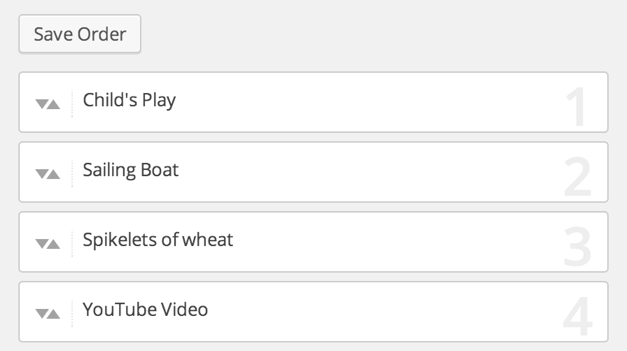
Other Gallery Page Options
- Select a category whose items will be displayed - you can do this in the "Display portfolio items from categories" custom field of the page. In this way you can create multiple gallery pages displaying different categories of items.
- Set the order of the portfolio items - you can select how the items will be ordered in the "Portfolio item order" custom field of the page. If you select "By Date" the last created item will be displayed first. If you select by "By Custom Order", the items will be ordered by the value set in their "Order" field. You can change the default custom order of the items in the Portfolio -> Custom Order section.
- Show/hide the category filter - you can disable/enable the category filter within the "Show portfolio category filter" custom field of the page.
- Set the number of items to be displayed per loading - you can do this in the "Number of portfolio items to show per load" custom field of the page. This number sets how many items will be initially loaded and how many items will be additionally loaded on every "Load More" button click.
- Change the default image size - you can do this in the "Base Image width" and "Base Image height" fields of the Grid Gallery page.
b. Full-width and full-height slideshow pages
The full-width and full-height slideshow pages are pages that contain an image slideshow which is displayed on the full screen without any additional content, with a thumbnail image container in the bottom. The Full-width page template displays an image to its full width - the display width is the same as the window width and the height varies depending on the image aspect ratio. This page template is mostly suitable for landscape oriented images.
The full-height page template displays the image in its full height, depending on the window size and the width varies depending on the image aspect ratio. This page template is suitable for both portrait and landscape oriented images.
As the steps for creating both template pages are the same, they are explained in this section:
Creating the pageIn order to make one page a full-width slideshow page you have to select the Template for this page to be Full width slideshow. In order to make one page a full-height slideshow page you have to select the Template for this page to be Full height slideshow.
If you would like to make this page a front page (to be opened by default when the site is visited) go to Settings » Reading » Front page displays » Select "A static page" and select the page that you have just created in the Front Page list.
Adding the images
- Click on the "Add Media" button above the main content area:

- Open the "Create Gallery" section. If you would like to upload new images click on the
"Upload Files" tab and upload the images. If you would like to add existing Media Library
images, click on the "Media Library" tab and select the images you like. After you select
the images, click on the "Create a new gallery" button.

- After this when you click on each image in the gallery, in its Caption field you can set a description to it. You can also change the default image order by dragging and dropping the images on different positions.
- When you finish editing the images Click on the "Insert Gallery" button. This will insert a gallery object into the content section of the page.
- Later if you would like to edit the images, click on the gallery object and click on its "Edit Gallery"
button:

All the slideshow settings can be changed in the "Slder Settings" » "Full-width slider" (for the full-width page) and "Slder Settings" » "Full-height slider" (for the full-height page) section of the Options panel. In this section you can set automatic thumbnail cropping and change some of the main animation settings.
c. Index/Blog page
Index page is the default home page that is opened when first installing the theme. This page actually is a blog page.
There are 2 different ways of using this template:
- As a home/front page- the blog will be opened by default on your site. To set the blog like this, you have to go to Settings
» Reading and select "Your latest posts" in the "Front page displays":

- As a normal, non-home page. In order to do this you have to create a new page, lets say that
its name is "Blog". After this you have to go in the Admin Panel » Settings » Reading and you have to select "A static page" option. Below this field you have to
select the page which will be your home page in the "Front page" field and you have to select the
name of the page that you have just created (in our case "Blog") in the field "Posts page". Now
your Blog page will contain the latest posts:

In order to exclude categories from the blog you have to go to the Expression Options in the section Pages » Blog » Exclude categories from blog. In this section you have to check the names of the categories that you want to be excluded.
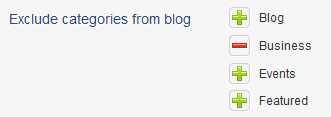
Defining the number of posts on the blog:
In order to define the number of posts per page that will be shown on the blog you have to go to the Expression Options in the section Pages » Blog » Number of posts per page and you have to edit the value of this field. Default is set to 5.
Setting a slider/static image for the page:In order to set a slider you have to go in the Expression Options in the section
Pages » Blog » Header. In this field you can select between Nivo Slider/Fader, Static Header Image and None.
-If a slider is selected, the default slider of the selected slider type will be automatically assigned to the blog page. If you have created
additional sliders, their name will be displayed in the relevant slider section of the drop-down list.
-If Static Header Image selected, you have to insert its URL
into the the Static Image URL field below.
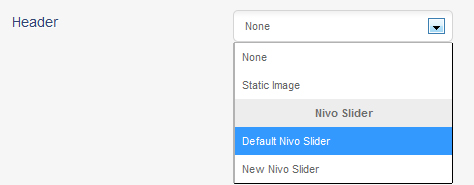
Selecting a layout for the page
For the blog page you can select the layout to be Right Sidebar, Left Sidebar or Full Width. You can do this in the Page Layout section. This setting will affect also the blog post, archive and search layouts.

The blog sidebar:
By default this page template uses the Default Sidebar. If you would like to use another sidebar, you can create one in the Expression Options » General » Sidebars and after that you can select the created sidebar in the field Sidebar in the Expression Options » Pages » Blog » section. To customize it you have to go to the Appearance » Widgets and find the selected sidebar. You can drag and drop widgets from the left into it.
Setting advanced blog pagination

In order to have advanced pagination enabled on your blog page (as on the screenshot above) you need to install the WP-Pagenavi plugin. You can read more about how to do it the section Plugins included.
The blog posts:
The blog posts look like this:

Selecting a format for the post:
The posts support three formats - Standard, Gallery and Video and the format can be selected in the "Format" section of the post:

Here is an explanation about each of the supported formats:
- Standard - will display a featured image as header of the post. You can read here about how to set a featured image to the post.
- Gallery - will display all the image attachments as a Nivo slider in the beginning of the post (as header of the post). You can read more about it here.
- Video - will display a video as header of the post. You can set the video URL in the "Video URL" custom field of the post. The theme uses the WordPress [embed] shortcode to insert the video, you can see the supported formats on the WordPress Embeds page. We have also included support for Flash videos (with .swf extension).
Hiding part of the content of the post with the "Read More" link:
Just before the text that you want to be hidden you have to click on the "Insert more tag" button (Alt+Shift+T):

Enabling threaded comments (with reply functionality):
In order to enable threaded comments, you have to go to Settings » Discussion and check the field "Enable threaded (nested) comments x levels deep"
d. Quick/Easy Gallery page
This is the default WordPress image gallery - the purpose of this gallery is to insert multiple images at once - you can very quickly create multiple galleries just for several minutes. Here is how the gallery looks like:
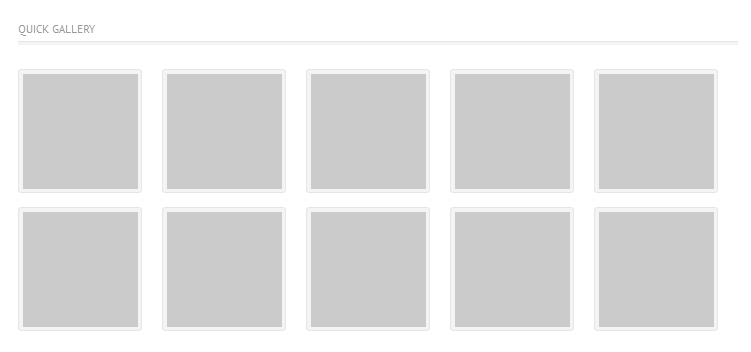
In order to create a quick gallery you have to:
- Create a new page (you don't have to set a page template to it)
- Click on the "Add Media" button above the main content area:

- Open the "Create Gallery" section. If you would like to upload new images click on the
"Upload Files" tab and upload the images. If you would like to add existing Media Library
images, click on the "Media Library" tab and select the images you like. After you select
the images, click on the "Create a new gallery" button.

- After this when you click on each image in the gallery, you can set a title and description to it.
- Use the "Gallery Settings" section to change the gallery settings:
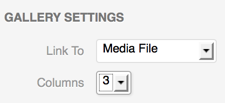
In the "Link to" select "Media File" and in the "Gallery Columns" field select 5 if the page is full width or 3 if the page contains a sidebar.
Click on the "Insert Gallery" button. - If you would like to change the default image size, you can do it in Settings » Media » Thumbnail Size field. Please note that if you change the default size, you would have to reupload the images again, as WordPress automatically crops the images during image upload only.
e. Contact Form page
The contact form page looks like this:

This page contains an AJAX contact form which visitors of your website can use to contact you.
To make one page contain a contact form you have to do some settings. When you create (or edit) your page, you should find the field Template and in it to choose the Contact form page option. After that immediately your page will contain a contact form.
To set a text in the contact page, just insert it as a content of the page.
Setting the email address to which to send the emailTo set the email address, you have to go to the Expression Options and in the section Pages » Contact find the field Email to which to send contact form message in. In this field you have to insert your email address.
As you can see in this section there are some other fields that you can edit. I have provided this feature in case that you need to translate your site or just don't like the text that is output.
Setting a sender e-mail address
You can set the e-mail address to which to send the messages in the Photolux Options » Page Settings » Contact » Email sender field.
Yahoo has recently published a DMARC policy of reject, meaning that all the emails that are sent from Yahoo emails, but not from the Yahoo servers, should be rejected by the email providers. This means that if your site visitor sets a Yahoo email and this email is set as a sender, you may not be able to receive the email (depending on the email provider that you use to receive the messages). Therefore, please make sure to set your custom email address in this field (such as [email protected], non-Yahoo address), so that you can make sure that you will receive all the emails from Yahoo users.
Setting the sidebarBy default this page template uses the Default Sidebar. If you would like to use another sidebar, you can create one in the Expression Options » General » Sidebars and after that you can set the custom field Sidebar and select the sidebar that you have just created. To customize it you have to go to the Appearance » Widgets and find the selected sidebar. You can drag and drop widgets from the left into it.
Setting the page layout
For this page you can select the layout to be Right Sidebar, Left Sidebar or Full Width. You can do this by setting the custom field Page Layout:

Setting a slider/static image for the page:
In order to set a slider, you have to set the custom field Header on the page. In this field you can select between Nivo Slider/Fader, Static Header Image and None.
-If a slider is selected, the default slider of the selected slider type will be automatically assigned to the blog page. If you have created
additional sliders, their name will be displayed in the relevant slider section of the drop-down list.
-If Static Header Image
has been selected, you can set the static image by setting the image as a Featured one. Here is explained how to do this.
f. The Default page
This is the page template that is assigned by default when a page is created. By default this page template uses the Default Sidebar. If you would like to use another sidebar, you can create one in the Expression Options » General » Sidebars and after that you can set the custom field Sidebar and select the sidebar that you have just created. To customize it you have to go to the Appearance » Widgets and find the selected sidebar. You can drag and drop widgets from the left into it.
Setting the page layoutFor this page you can select the layout to be Right Sidebar, Left Sidebar or Full Width. You can do this by setting the custom field Page Layout:

Setting a slider/static image for the page:
In order to set a slider, you have to set the custom field Header on the page. In this field you can select between Nivo Slider/Fader, Static Header Image and None.
-If a slider is selected, the default slider of the selected slider type will be automatically assigned to the blog page. If you have created
additional sliders, their name will be displayed in the relevant slider section of the drop-down list.
-If Static Header Image
has been selected, you can set the static image by setting the image as a Featured one. Here is explained how to do this.
Changing the theme style
All the style settings can be done in the Expression Options » Styles
Changing the background color:You can select a background color within the predefined colors we have provided from the Predefined Background Colors field.

If you would like to use another custom color, rather than one of the predefined colors, you can select your color in the Custom Background Color field below:
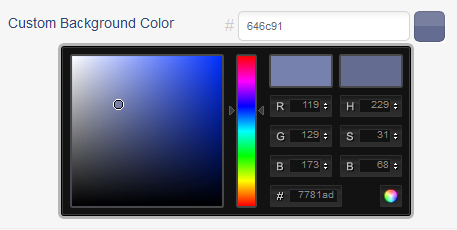
Changing the background image/pattern:
If you would like to use a background pattern for the theme, rather than the default one, you can choose one from the Background Pattern section.

If you would like to use your own custom pattern, you can upload it within the "Custom Background Pattern" field below.
If you would like to use a full width non-repeatable image, you can upload one within the "Full Width Background Image" field. We recommend that the image is neither too big or too small, as big images would take longer time to load and smaller images wouldn't look nice resized on higer resolutions - a medium sized image would be around 1000 pixels wide.
These are the main style settings that you can do on the theme. In the Styles section there are some other custom settings that you might need to change such as text size, different sections' colors, etc.
Styled elements and shortcodes back to top
Important: If you are running WordPress 5.0 or newer, please make sure to install the Classic Editor plugin. This theme supports the classic editor only and a major part of its elements rely on the classic editor.
a. Formatting Buttons

There are buttons for almost all of the styled elements that the theme provides. These buttons allow you to more easily insert styled elements and also you are able to see how they will look from the editor.
Inserting Lighbox imageOne way to insert image lightbox is to use the "Lightbox Image" button. Another way is to insert the image into the post (via the "Add Media" button), after that click on the image » an Edit Image button will be displayed. You have to click on this button, and in the window that is opened you have to click on the "Advanced Settings" section. In this section, in the field "Link rel" you have to insert the word lightbox. This automatically will set the lightbox functionality to the image.
b. Shortcodes
Some elements, such as the jQuery tabs, can be displayed by using shortcodes - in order to use a shortcode
you just have to paste its code into the content text area of the page/post.
Available shortcodes:
The jQuery tabs look like this:

[tabs titles="Title One, Tab Two, Tab Three" width="small"][pane]Tab One Content[/pane] [pane]Tab Two Content[/pane] [pane]Tab Three Content[/pane][/tabs]
As you can see, in the tabs element you can specify the width of the tab title. The available options are "small", "medium" and "big".
Note:Please make sure that all the shortcode tags are on the same line, but separated with at least a space, for example:... [pane]Tab One Content[/pane] [pane]Tab Two Content[/pane] ...
Accordion
The Accordion looks like this:

[accordion][apane title="First Pane"]Pane One Content[/apane] [apane title="Second Pane"]Pane Two Content[/apane] [apane title="Third Pane"]Pane Three Content[/apane][/accordion]Note:Please make sure that all the shortcode tags are on the same line, but separated with at least a space, for example:
... [apane]Tab One Content[/apane] [apane]Tab Two Content[/apane] ...
Sidebar contact form
The sidebar contact form looks like this:
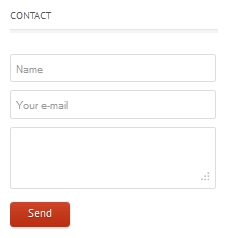
You can insert this contact form in the sidebar or footer section just by using the WordPress Text widget and inserting the following shortcode into it:
[contactform]You can set the email to which to send the messages in the Expression Options » Page Settings » Contact section.
Fonts back to top
All the fonts settings can be done in the Expression Options » Style settings » Fonts section. By default the theme uses a Google Font - "PT Sans".
Using Google fontsIn order to use Google Fonts, the field "Enable Google Fonts" should be set to "ON". As mentioned above, the theme already uses a font from the Google Fonts API. If you would like to remove this font, and use another ones, you can remove the old font by clicking on the red X button of their container and you can add the new ones in the text area provided within the "Add Google Font". When adding the new font, please make sure that you insert the URL of the font only, not the whole embed link. For example, if you would like to insert the Nobile font, you have to click on the "Quick Use" button:

In the new window that will be opened, select the settings according your needs and from the embed sectuion you have to copy only the value that is contained within the href property:

After you add the font URL in the "Add Google Font" field, you have to set the theme use this font. You can do this, by setting its font name in the "Headings font family" or "Body text font family" field, depending where you would like to use this font. For example, if you would like to add the font for the headings, you first have to get its font name from the Google page:
 and insert its name within the "Headings font family" section:
and insert its name within the "Headings font family" section:

The other fonts, that go after this font name are the fonts that will be used, in case there is some problem with loading the font from Google.
You can enable Cufon font replacement by setting "ON" in the "Enable Cufon for headings" field. When Cufon is enabled the selected font will be set for all the main headings, and for the headings this font will be used with higher priority than any font settings set in the below section or within the style.css file. With Cufon enabled, you can still use Google or standard fonts for the rest of the sections.
If Cufon enabled, you can select either one of the fonts that the theme goes with (in the "Heading Cufon Font" field) or upload your own font within the "Custom Heading Font" field. The font to upload should be in JavaScript format and you can generate this JavaScript file on the following page: http://cufon.shoqolate.com/generate/
Translation back to top
For this theme we have provided the possibility to easily translate/change the built-in words from the admin panel, without having to edit the PHP files. You can do this in the Expression Options in the Translation section. For the contact form you have to edit the fields in the Pages » Contact section.

Setting a multi-language installation
If your WordPress installation supports more than one language, you can set the theme built in words change depending on the selected language. In order to do this you have to follow the following steps:
- In Expression Options » Translation » Settings select "ON" for the "Enable Translation" field.
- In the same section select the locale for the default language. If your default langauge is English, you don't have to change this field. If, for example, you would like to change the default language to German, in this field you have to insert de_DE. Here you can see some examples of locales. For the default installation language, the theme will use the words that are set in the Expression Options » Translation section.
- Create .mo files for the additional languages
In the lang folder within the main theme folder you will find a file called default.po. You have to open this file with a program that can generate .mo files, such as PoEdit. Once you open it, you can insert the words in the additional language. Here is an example, with the file opened with PoEdit and the meanings of the words inserted into English:

In the same way you can insert the translations in the additional language. Once you save the document, a .mo file will be generated in the directory you specify. You have to rename this .mo file to the locale of the language used. For example, if this language is French, the name of the file should be fr_FR.mo. After that, you have to insert this .mo file in the lang directory of the theme.
Plugins included back to top
The theme goes with some additional plugins included:
- Classic Editor - this is the only plugin that is required by the theme. You will need this plugin in order to add the theme elements to the content of your pages and posts. You will be propmted to install it automatically once you activate the theme. It can be downloaded from https://wordpress.org/plugins/classic-editor/
- Pexeto's portfolio posts loader - its purpose is to display the latest portfolio thumbnails in the sidebar
- WP PageNavi - displays an advanced blog pagination - downloaded from http://wordpress.org/extend/plugins/wp-pagenavi/
- Simple Google Map - displays a Google Map in the sidebar - downloaded from http://wordpress.org/extend/plugins/simple-google-map/
All the optional widgets/plugins (except the required Classic Editor plugin) are located within the plugins folder of the download folder. In order to activate them, you have to go to the WordPress admin panel -> Plugins -> Add New -> click on the Upload link and find the plugin file you want to install on your local file system. After the plugin has been uploaded successfully you need to click on the Activate link. For the WP PageNavi plugin only activation is needed. For the other two you need to go to the Widgets section and drag and drop them to the sidebar you like.
Note: The Contact Form widget that you see on the demo in sidebar section is not added via plugin, but with a shortcode. It is explained how to add a contact form in the Shortcodes section above.
CSS Files back to top
The theme contains the following CSS files:
- style.css - the main CSS file containing the styles for the default dark skin
- style_ie7.css - for Internet Explorer 7 and older versions
- style_ie8.css - for Internet Explorer 8
- prettyPhoto.css - style for the PrettyPhoto plugin
The first file (style.css) contains all of the specific stylings for pages. The file is separated into sections:
- CSS Restart
- Basic Text and Heading Styles
- Basic Document Styling
- Sliders
- Content
- Portfolio
- Sidebar
- Footer
- Widgets and Page Templates
- Elements
- Others
- Updates
For each of the main parts of the website there are comments. For example, for the footer the comments look like this:
/*-------------------- FOOTER --------------------*/ --footer styles here--
Javascript files back to top
The theme contains the following JavaScript files:
- grid-gallery.js- this file contains the Grid Gallery page functionality.
This file also includes the following third party libraries:
- jQuery Masonry - downloaded from http://masonry.desandro.com
- John Resig's templating script - downloaded from http://ejohn.org/
- jQuery Touchwipe - downloaded from http://www.netcu.de/jquery-touchwipe-iphone-ipad-library
- jQuery imagesLoaded plugin - downloaded from http://github.com/desandro/imagesloaded
- Mousewheel - downloaded from http://brandonaaron.net/code/mousewheel/docs
- mwheelintent - downloaded from http://www.protofunc.com/scripts/jquery/mwheelIntent/
- rotation script - downloaded from http://javascriptisawesome.blogspot.com.au/2011/09/jquery-css-rotate-and-animate-rotation.html - main.js- this is the main script for the theme. It uses some simple functions used in the website like validation and making AJAX request for sending email.
Also, in order to decrease the number of JavaScript file requests, it contains the code from another JavaScript libraries/plugins:
- underscore.js - downloaded from http://documentcloud.github.com/underscore
- jQuery Tools - downloaded from http://flowplayer.org/tools/download/index.html
- Pretty Photo - this ithe jQuery plugin for lightbox effect for the images on the portfolio page- downloaded from http://www.no-margin-for-errors.com/projects/prettyPhoto-jquery-lightbox-clone/#download
- jQuery Easing - for the animation transitions- downloaded from http://gsgd.co.uk/sandbox/jquery/easing/
- hoverIntent - downloaded from http://cherne.net/brian/resources/jquery.hoverIntent.html
- slideshow.js - containing the fullscreen slideshow functioality (by Pexeto)
- cufon-yui.js - downloaded from http://cufon.shoqolate.com/generate/
- jquery.nivo.slider.pack.js- the Nivo slider- downloaded from http://nivo.dev7studios.com
- colorpicker.js - script for the color picker- downloaded from http://eyecon.ro/colorpicker/#download
- jquery-ui.js- jQuery UI - downloaded from http://jqueryui.com/
- jquery.cookie.js - jQuery Cookie - downloaded from http://plugins.jquery.com/project/Cookie
Font files - all fonts have been downloaded from http://www.fontsquirrel.com/ and have been generated from http://cufon.shoqolate.com/generate/
- andika.js
- caviar_dreams.js
- charis_sil.js
- chunk_five.js
- comfortaa.js
- droid_serif.js
- kingthings_exeter.js
- luxy_sans.js
- sling.js
- vegur.js
PhotoShop files and image resources back to top
The theme comes with PhotoShop files included - they are located within the photoshop_files folder of the main downloaded zip file. Every PSD file has a clear structure and is organized in groups with well named layers.
Special thanks to all the great graphic resorces to:
- Mono Social Iconshttp://icondock.com/free/mono-social-icons
- Pixel patterns http://naomiatkinsonproducts.com/
- Repeatable Pixel Patterns http://www.premiumpixels.com/20-repeatable-pixel-patterns/
- Tango icons: http://tango.freedesktop.org/Tango_Desktop_Project
- Vector Patterns http://speckyboy.com/2010/04/08/6-free-vector-seamless-backgrounds-source-files/
- Seamless Patterns http://www.premiumpixels.com/20-seamless-photoshop-grid-patterns/
PHP files back to top
Except the main files needed for this theme to run, here are the other external PHP files used:
- aq_resizer.php- the purpose of this script is to resize/crop images to smaller sizes. The file is downloaded from: https://github.com/sy4mil/Aqua-Resizer/
- Envato WordPress Toolkit Library - downloaded from https://github.com/envato/envato-wordpress-toolkit-library
- class-tgm-plugin-activation.php - TGM Plugin Activation - downloaded from https://github.com/thomasgriffin/TGM-Plugin-Activation
Troubleshooting back to top
In this section you can check the most common issues and the solutions for them
- Fail to install the theme
If you experience any problems with installing the theme, please check the following:
- Please make sure you have installed the theme as described in the Activating the theme section
- If you have used the WordPress uploader and can't upload the theme: as the theme is versatile and provides lots of options, its zip file is bigger than standard themes and some servers can't handle an upload with that file size. In this case you have to use an FTP client to upload the theme.
- If you have used an FTP client to upload the theme:
* make sure the theme main files (such as style.css and index.php) file are located just within one directory apart the wp-themes directory. The right way to locate your root theme files is for example themes/Expression but not themes/Expression/Expression
* the problem you are experiencing may be related with the FTP client used - in this case you can try with another one- we recommend FileZilla FTP client. - Make sure you have WordPress 3.0 or higher installed
- Make sure your server is running PHP version 5 or higher. Although when developing the theme, we have followed the main rules for cross-version compatibility, we have the possibility to test the theme on servers running versions higher than 5.0. If your server runs an old PHP version and you get any errors when installing the theme, you can contact the hosting support and ask them update PHP to a newer version.
- Portfolio thumbnail/Slider image not generated
Sometimes the image resizing script doesn't generate the image due to the following reasons:
*lib/utils/cache directory is not editable (at least 755)
*original image size is too big (more than 2000 pixels)
*original image is not located within the WordPress installation directory
*your site is hosted on a HostGator server - HostGator have some known incompatibilities regarding timthumb and in this case you have to contact the support and ask them to make your server settings compatible for timthumb. On the this page you can find an article with an email template that you can use to send them the query.
- A "406 Not Acceptable" error occurs when saving the option in the Expression Options page
This error may occur on some servers, because of some security settings and it is related with the jquery.cookie.js script which is used for saving the last edited tab within the options page. In this case, apart of changing the server settings, the easiest way to fix this would be to disable this functionality. You can do this by opening the lib/functions/general.php file and change line 101:
pexetoOptions.init({cookie:true});to be like this:pexetoOptions.init({cookie:false}); - Portfolio section does not exist in the main menu
This theme is available for WordPress version 3.0 or higher, so please make sure you have the latest version installed.
- Appearance » Menus section does not exist
This theme is available for WordPress version 3.0 or higher, so please make sure you have the latest version installed.
- Contact form not sending emails
This issue is mostly likely to happen if you have uploaded the theme via an FTP client or uploaded the whole download zip file rather the theme only zip file. If so, you need to make sure that the main theme files are contained within just one directory of the wp-themes directory, not more. For example for the style.css file it is correctly to be located within http://site.com/wp-content/themes/Expression/ but not http://site.com/wp-content/themes/Expression/Expression/
Also another reason for this issue is that the server where the theme is hosted has some restrictions set about email sending.
- Style changes within the Options panel do not affect the theme
This issue is mostly likely to happen if you have uploaded the theme via an FTP client or uploaded the whole download zip file rather the theme only zip file. If so, you need to make sure that the main theme files are contained within just one directory of the wp-themes directory, not more. For example for the style.css file it is correctly to be located within http://site.com/wp-content/themes/Expression/ but not http://site.com/wp-content/themes/Expression/Expression/
- Portfolio items not loading on Internet Explorer
This issue is most likely to happen if you have a broken image URL has been inserted. In this case, please make sure that all the image URLs that you have inserted are URLs of existing images.
- In the Expression Options Upload Button/Color Picker/Add Slider Image Functionality is not working
This is most likely to be caused by a plugin you have installed. You can try to deactivate all the plugins you have installed and check if it will work. If it turns out that a plugin is causing this, you can deactivate the plugin until you set the theme and activate it back once you are done.
Support back to top
We will do our best to assist with questions directly related to the theme set up, however please note that theme support is completely voluntary for ThemeForest authors. Therefore before you contact us, please consider finding an answer to your question in:
- The relevant section of the documentation
- Search our Knowledgebase which contains frequently asked questions
- Troubleshooting section above
- WordPress Codex for general WordPress questions
- Google for general questions
Updates back to top
a. Installing an update
You can install an update of the theme either automatically by using the Envato Market Plugin or manually.
If you have modified the theme's code: your modifications will be lost when you install the update. Please create a backup of your code modifications and consider using a child theme instead of modifying the theme's code. More info here.
Due to the retirement of the old Envato API, since version 1.4.3 of the theme we have changed the way automatic updates are installed from the Dashboard. We had to remove the Envato Toolkit Library from the theme and recommend installing the Envato Market Plugin that can replace it.
In order to install updates automatically from the dashboard, you first need to install the Envato Market Plugin. The Envato Market Plugin, created by the Envato team, can be used to install updates of all of your ThemeForest and CodeCanyon items.
Installing the Envato Market Plugin
- Download the plugin
- If you are running version 1.4.3 or later, you should see a notification in your Dashboard to automatically install the plugin
- If you are using an older version or you don't see the dashboard notification:
- Download the plugin from here or
- Go to the Envato Market Github page, scroll down to the "Installation" section of the plugin description and click on the "download" link. Do not use the "Download ZIP" link of the repository!
- Install the plugin. After you have downloaded the plugin, you can install it from the Plugins » Add new » Upload Plugin section and select the downloaded plugin zip file.
Configuring the Envato Market Plugin
Once you have the Envato Market Plugin installed and activated, you will need to setup your API token in order to be able to use it. To setup your token, visit the "Envato Market" page of your dashboard and follow the instructions on the page. This page includes a link to the Envato Market site where you can easily generate your token.
Once you setup your token, you should see a "Themes" tab on the page where you can install updates of all your ThemeForest themes. Clicking on the "Update Available" button will start installing the update.
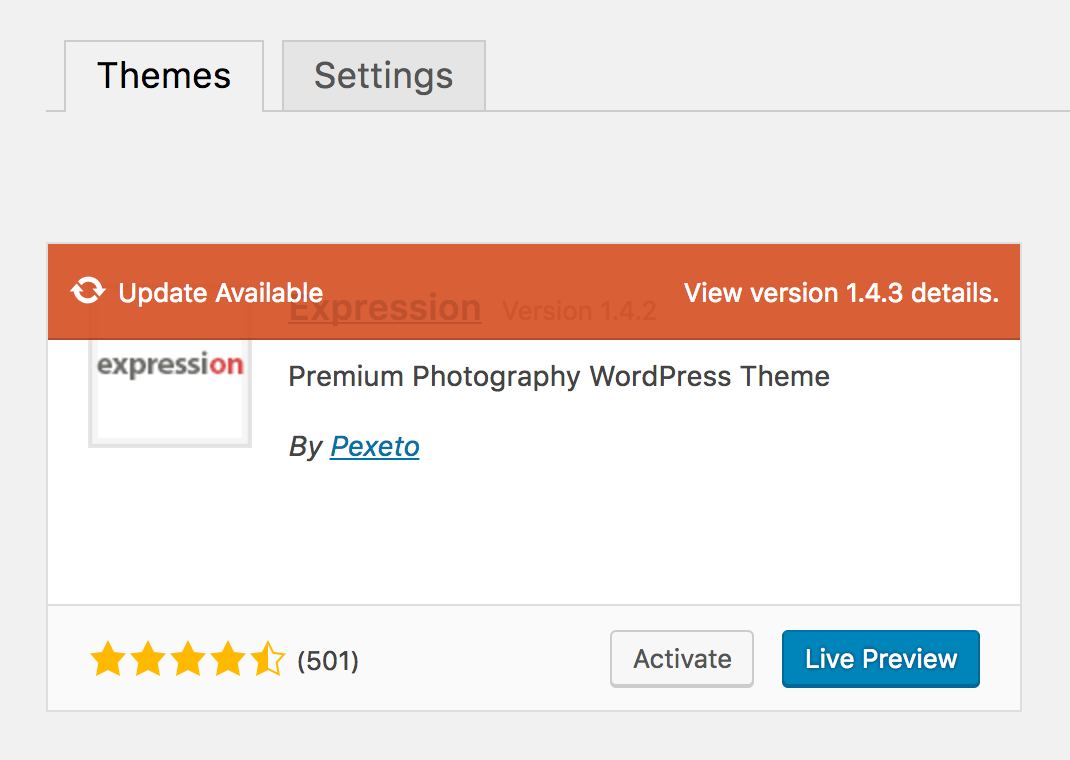
If you experience issues with using the Envato Market Plugin
- Check the Envato Market Plugin Issues Page to see if this is a known issue
- Consider reporting the issue on the Envato Market Issues Section
- Although the Envato Market plugin is not built by us, feel free to open a ticket/bug report on our Support Site so we can see if there is anything that we can do to help
- You can alternatively just install the update manually, as explained in the next section.
Installing an update manually
There are two main ways of installing an update manually:
- By uploading the theme as a new theme (recommended)- this is an easier way to accomplish this.
First you have to either delete your current theme or rename its folder on the server. To rename the theme, log in via FTP to the server, navigate to the WordPress installation folder » wp-content » themes folder where you will find the theme folder that you can rename. After this, just upload the updated theme zip file via the built in WordPress theme uploader as a new theme as explained here and activate the theme.Note: Please note that with the activating of the new theme it is possible your menu setting not to be saved for the new theme. If so, you just have to go to Appearance » Menus » Theme Locations, select the menu (it will be still there) and press the "Save" button.Once you install the updated theme and make sure that everything is working normally, you can go back to the Themes section and delete the older version of the theme.
- Via FTP - you can use an FTP client (such as FileZilla) and replace all the theme files with the updated ones. The theme folder is located in the WordPress installation folder » wp-content » themes folder of the server.
b. Version 1.1.0
This update includes:
- Implemented descriptions for images in the fullscreen slideshow pages (use the "Description" field of the image)
- Child theme support: the initial release of the theme included child theme support for all the main styles and all the page templates. In this update we have also included child theme support for all the functions used in the theme.
- Implemented improvements into the PrettyPhoto lightbox plugin for mobile devices - now images are displayed to the full size of the screen on mobile devices.
- Added a 500px icon to the default icons set
- Added options to change the default texts in the contact form message (in Expression Options -> Page Setting -> Contact)
- Added featured image and description to pages when they are shared/liked on Facebook (before only posts and portfolio items had this functionality included)
- Code improvements and small issues fixes
c. Version 1.2.0
This update includes:
- Changed the way the images are added in Grid Gallery portfolio items and
fullscreen slideshows to work best with the new WordPress 3.5 Media screen.
Now they require to insert a WordPress gallery into the content of the page/item
and the images that the gallery contains will be used. This allows using images
from other posts and pages which already exist in the Media library. Updating
from older version to version 1.2.0 will automatically insert the gallery
into the content of the fullscreen slideshow pages, slider and lightbox portfolio
items. For more information about how to manage your items, please refer to the:
- Full-width and full-height slideshow pages
- Portfolio Grid Gallery page
Also, you can read this article about the new changes. - Added an option to load a Nivo slider from the existing sliders in Expression Options -> Nivo Slider section into the content of a post/page with a shortcode and also in Gallery post types. For more information about using the shortcode please refer to the Nivo slider in the content of a page/post section.
- Social sharing in gallery sliders - when sharing an item, by default the featured image of the item is shared. In this update we have included the functionality to share the first image in the item image set when a featured image is not set to the item.
- Updated Timthumb to the latest version
- Code improvements and small issue fixes
d. Version 1.2.1
This update includes:
- Fixed an issue about the number of the images that is displayed on the item in the gallery not being correct when the images are not attachments of the portfolio item.
e. Version 1.2.2
This update includes:
- WordPress 3.6 compatibility modifications: fixed an issue with the dialogs in the admin panel - on WordPress 3.6 the dialogs sometimes appear behind some of the elements
- Added an Instagram icon to the header social icons set
- Updated the Menu instructions - included instructions for WordPress 3.6
- Portfolio Posts Loader widget - set the thumbnail image to be automatically generated from the gallery images of the portfolio item when a featured image is not set to the item
- Other minor bug fixes and code improvements
f. Version 1.2.3
This update includes:
- Fixed the rotation of the gallery slider arrows for the next/previous project
- Fixed some minor style issues in the admin with the upcoming WordPress 3.8
- WooCommerce improvements - added a woocommerce.php template to fix some layout and style issues
- Updated Timthumb to the latest version
- Fixed a style issue with the Nivo slider when it is added into the content of a full-width page
- Other minor bug fixes and code improvements
g. Version 1.3.0
This update includes:
- Fixed some compatibility issues with the upcoming WordPress 3.9:
- Full-width slideshow page fix: after clicking the fullscreen button, the first image of the slideshow always displayed instead of the current image
- Improved the appearance of the theme's dialogs in the admin panel on WordPress 3.9
- Other minor fixes
- Added a Custom Order functionality to the Portfolio section ( Portfolio » Custom Order section) that allows reordering the portfolio items by dragging and dropping them. Please note that the "By Custom Order" option should be selected in the "Portfolio item order" field of the gallery page in order the custom order to be applied to the gallery items.
- Fixed: a horizontal scrollbar displayed in the gallery slider preview on Firefox
- Improved the way YouTube and Vimeo videos are added with the content editor buttons - now they are added via shortcodes that use the default WordPress embed functionality
- Fixed: fullscreen slideshows caption displayed over the mobile drop-down menu
- Fixed: a bug with the colorpicker display in the editor dialogs
- Other various code/style improvements and minor bug fixes
h. Version 1.3.1
This update includes:
- Improved: the additional styles are now printed into the head of the document, instead of loading them as a separate file - this will improve the performance of the page load
- Improved: blog posts query code
- Improved: the code of the main.js file to prevent an error with Firebug (add-on for Firefox) to load the scripts when it is active
- Improved: the format of the documentation - now it is easier to navigate with the table of contents always displayed on the left of the page
- Updated the Envato WordPress Toolkit Library for the automatic theme updates
- Fixed: a warning message on the Nivo slider sometimes displayed under some circumstances
i. Version 1.3.2
Bugfix release - this update includes:
- Fixed: Blog page not loading the posts correctly when a Nivo slider is set as a header of the page
j. Version 1.4.0
This update includes:
- Improved: Replaced Timthumb image resizing script with the Aqua Resizer script
- Improved: Replaced the image upload functionality with a Media Library image select
- Improved: The performance of the update notifier functionality in the admin in case it fails to load the updates data
- Improved: Contact form - added a sender email option to avoid messages failing to be sent due to the Yahoo DMARC reject policy. For more information, please refer to the Contact Form Page section.
- Other general improvements and minor bug fixes
k. Version 1.4.1
This update includes:
- Security fix: Updated the PrettyPhoto lightbox plugin to version 3.1.6 to fix a recently found XSS vulnerability
- Made the custom theme editor buttons always visible regardless of the Toggle Toolbar button state
l. Version 1.4.2
This update includes:
- Fixed: Tabs and Accordion elements not working properly with WordPress 4.5
- Code improvements
m. Version 1.4.3
This update includes:
- Major change affecting the automatic updates from the dashboard: removed the Envato Toolkit Library that handles automatic updates due to the retirement of the old Envato API (that Envato Toolkit uses). Implemented a script to install the Envato Market Plugin, which is the new tool to install automatic updates from the dashboard. For more information please refer to the Updates section.
n. Version 1.4.4
This update includes:
- Add support for the WordPress 4.9.6 comment form cookie checkbox. The commenter cookie is used to pre-fill the name,
email and URL fields of the comment form when the commenter intends to post another comment. It also allows the commenter to preview
and delete any comments awaiting moderation.
WordPress 4.9.6 automatically includes the cookie checkbox in the comments form, however you need to update the theme to version 1.4.4 in order for the checkbox to be displayed.
o. Version 1.4.5
This version includes:
- WordPress 5.0 Preparation: Make the Classic Editor plugin required by default. This theme supports the classic editor only and a major part of its elements rely on the classic editor. If you wish to use Gutenberg, you can do so by not installing the Classic editor plugin, however please keep in mind that some of the theme elements (especially the gallery based ones) might not function properly, as they were designed to be added via the Classic Editor. You can learn more in this article.
- Load the gallery YouTube and Vimeo lightbox video players over https
- Minor bug fixes
p. Version 1.4.6
This version includes:
- Fixed some compatibility issues with the upcoming WordPress 5.3:
- Fullscreen slider and portfolio slider images squished/mispositioned
- Nivo slider animations not working properly
- Options panel select elements broken styles
q. Version 1.4.7
This version includes:
- Preparation for WordPress 5.5, including:
- Portfolio gallery not working
- Full-width/full-height sliders not working
- Nivo slider not working
- Error when adding new sidebars/header social icons in options panel
- Editing nivo slider slides does not load the saved description
- Other smaller JavaScript errors caused
- Implemented support for the WordPress 5.5 sitemaps feature, including:
- Made the nivo slider post types non-public so they are not added to the sitemap
- Added a section under Expression Options -> General -> SEO -> WordPress 5.5+ sitemaps allowing you to customize the portfolio items added to the sitemaps. In this section you can exclude items from sitemaps based on their type and also disable the portfilio category taxonomy sitemap.
- General code improvements
Once again, thank you so much for purchasing this theme! If you like it, please don't forget to rate it on the ThemeForest site.
Pexeto


